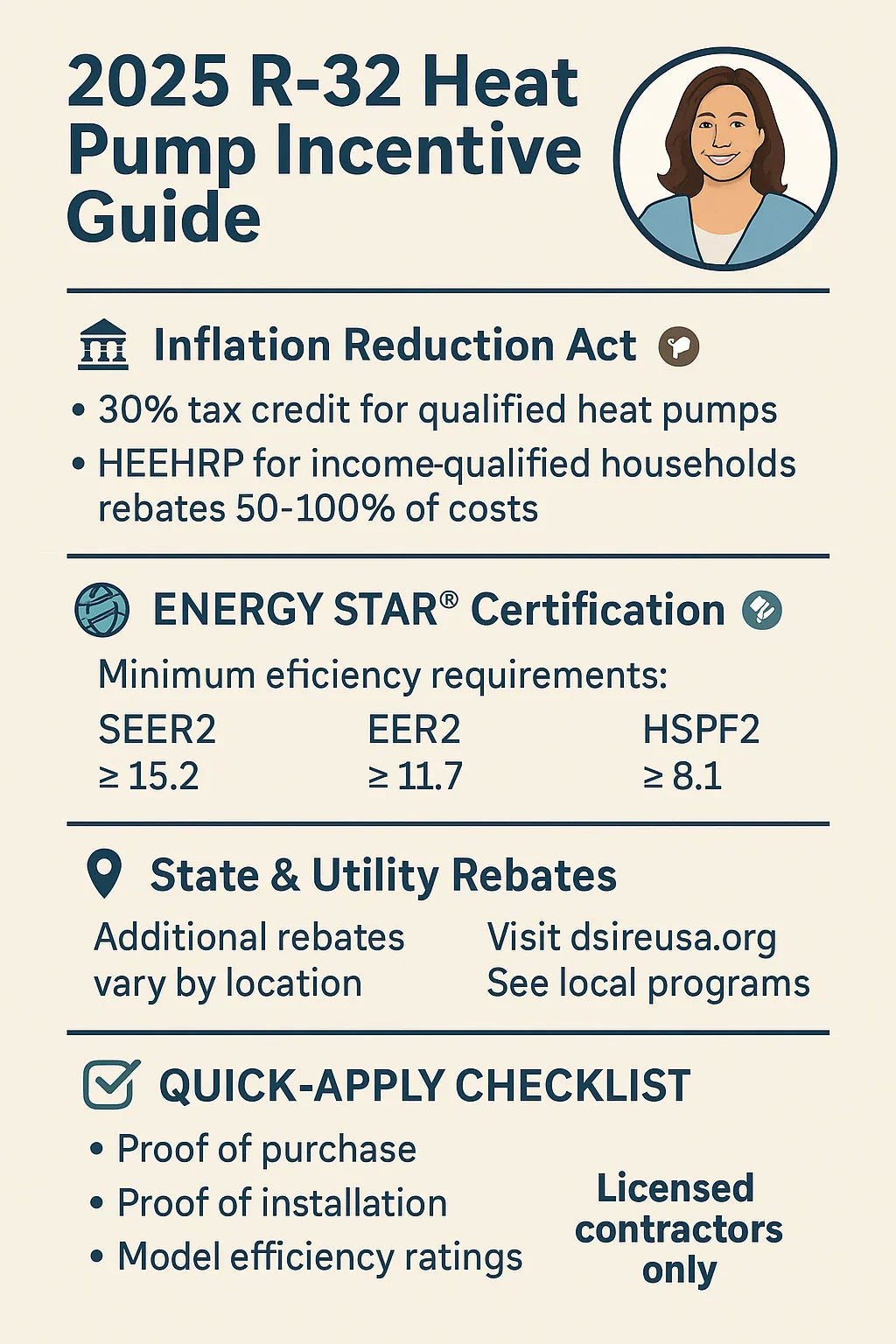💬 Introduction: Samantha’s $1,800 Surprise Check
When I upgraded to my 3-ton R-32 heat pump last year, I was focused on comfort, efficiency, and reducing my carbon footprint. But a few months after installation, I got a check in the mail for $1,800.
I had completely forgotten that my system qualified for multiple rebates and tax credits—and honestly, I almost didn’t apply because the paperwork looked intimidating.
If you’re shopping for a 3-ton R-32 heat pump in 2025, this guide will help you figure out which incentives you can get, how to qualify, and how to avoid missing out.
🏛️ 2025 Federal Tax Credits & Rebates
The Inflation Reduction Act (IRA) continues to make heat pump upgrades financially attractive in 2025.
1. Energy Efficient Home Improvement Credit
-
Credit covers 30% of the total installed cost, up to $2,000 per year for qualified heat pumps (Energy.gov IRA Overview).
-
Applies to both equipment and labor.
-
Must meet ENERGY STAR® certification requirements.
2. High-Efficiency Electric Home Rebate Program (HEEHR)
-
For low- and moderate-income households.
-
Covers 100% of project costs up to $8,000 for eligible households (Rewiring America HEEHR Guide).
-
Income caps vary by state and household size.
🌎 ENERGY STAR® Requirements
Your 3-ton R-32 heat pump must meet 2025 ENERGY STAR® efficiency criteria to qualify for federal credits:
| Region | SEER2 (Cooling) | EER2 (Cooling) | HSPF2 (Heating) |
|---|---|---|---|
| All Regions | ≥ 15.2 | ≥ 11.7 | ≥ 8.1 |
-
R-32 refrigerant itself does not affect ENERGY STAR® eligibility.
-
Efficiency ratings depend on the model’s design and components, not just refrigerant type (ENERGY STAR Heat Pump Criteria).
📍 State & Local Incentives
In addition to federal credits, many states and utilities offer rebates for heat pump installations.
Examples for 2025:
-
California (Tech Clean California Program) – Up to $3,000 rebate for qualifying heat pump installations.
-
New York (NY Clean Heat Program) – $1,000–$5,000 depending on system size and efficiency.
-
Massachusetts (Mass Save Program) – Up to $10,000 for whole-home heat pump conversions.
You can find programs in your area using the DSIRE Incentives Database.
📑 What You’ll Need to Apply
From my experience, you’ll save a lot of headaches if you gather these before starting your application:
-
Proof of Purchase – Itemized receipt with model number.
-
Proof of Installation – Invoice from a licensed HVAC contractor (DIY installs are typically ineligible).
-
Efficiency Ratings Sheet – Manufacturer’s documentation showing SEER2, EER2, HSPF2.
-
Permit Documentation – Some programs require proof of approved building permits.
⚠️ Common Pitfalls That Disqualify Applications
I’ve seen neighbors miss out because of small mistakes:
-
DIY Installations – Almost all rebate and tax credit programs require licensed professional installation.
-
Buying Non-Qualifying Models – Even efficient systems won’t qualify if they’re missing ENERGY STAR® certification.
-
Missing Deadlines – Many programs require you to apply within 90–180 days of installation.
-
Incomplete Paperwork – Missing one document can delay or void your application.
🧮 Samantha’s Maximizing Strategy
When I installed my R-32 system, I stacked incentives like this:
-
$1,800 Federal Tax Credit (IRA Energy Efficient Home Improvement Credit).
-
$500 State Rebate from my local energy office.
-
$1,200 Utility Rebate from my electric provider.
Total Incentives: $3,500 — which cut my net project cost by almost 40%.
Tip: Time your project to coincide with utility rebate funding cycles—some programs run out of money mid-year.
💬 Closing Thoughts
If you’re installing a 3-ton R-32 heat pump in 2025, there’s a good chance you qualify for thousands of dollars in incentives—but only if you choose a qualifying model, hire a licensed installer, and apply on time.
My advice: don’t leave free money on the table. A few hours of paperwork could mean years of savings.
In the next topic we will read about: Troubleshooting Guide: What to Do If Your R-32 Heat Pump Isn’t Heating or Cooling







